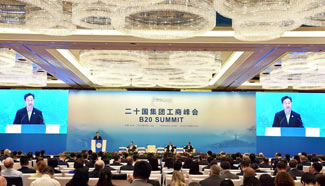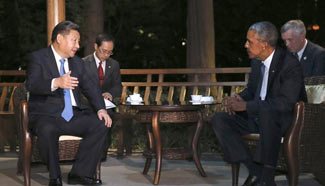HANGZHOU, Sept. 4 (Xinhua) -- Chinese President Xi Jinping met with U.S. President Barack Obama on Saturday ahead of the Group of 20 (G20) summit in China's eastern city of Hangzhou. Following is the full text of an outcome list of the meeting from the Chinese side.
Chinese Outcome List of the Meeting Between the Chinese and U.S. Presidents in Hangzhou
On September 3, 2016, President Xi Jinping of the People's Republic of China held meetings with President Barack Obama of the United States of America during the G20 Hangzhou Summit. The two sides had in-depth, candid and constructive talks on China-U.S. relations and major regional and global issues of common interest, and reached a wide range of important consensus. According to the Chinese foreign ministry officials, the consensus and outcomes reached by the two sides are as follows:
1. The New Model of Major-country Relationship Between China and the United States: The two sides commended the important progress made in the building of a new model of major-country relationship between China and the United States since the meeting between the two heads of state in Sunnylands in June 2013, and agreed to continue the joint endeavor to move forward this relationship in accordance with the consensus reached by the two presidents. The two sides will maintain close high-level communication and institutionalized dialogues, continue to enhance strategic mutual trust, deepen coordination and cooperation at bilateral, regional and global levels, manage differences and sensitive issues in a constructive manner, and promote the sustained, sound and steady development of China-U.S. relations.
2. China and the United States recognize that the two economies are closely interconnected and each country has a strong stake in the economic prosperity of the other. Policies that lay the foundation for strong and sustainable growth in both economies are essential to improving the livelihoods of Chinese and American citizens, as well as countless others around the world. To this end:
-- China and the United States commit to use all policy tools - monetary, fiscal and structural - to foster confidence and strengthen growth. Monetary policy will continue to support economic activity and ensure price stability, consistent with central banks' mandates, but monetary policy alone cannot lead to balanced growth. Fiscal policy should be used flexibly to strengthen growth, job creation and household demand, and can complement and support the implementation of structural reforms.P -- China and the United States jointly reaffirm their G20 exchange rate commitments, including that they will refrain from competitive devaluations and not target exchange rates for competitive purposes. China will continue an orderly transition to a market-determined exchange rate, enhancing two-way flexibility. China stresses that there is no basis for a sustained depreciation of the RMB. Both sides recognize the importance of clear policy communication.
-- The United States welcomes the commitments China has made on economic reform, especially on supply-side structural reform, and progress achieved so far, including efforts to strengthen the fundamental role of domestic consumption in driving China's economic growth. China commits to steadfastly advance supply-side structural reform, concentrating on cutting excess capacity, reducing inventory, deleveraging, lowering costs, and enhancing support for addressing weaknesses in economic and social development, to support China's transition to a more sustainable growth path. China commits to balance stable economic growth and structural adjustment, and expand domestic demand by increasing household consumption, increasing the service sector's proportion of the economy and ensuring investment is high quality and driven by the private sector. China will continue to simplify administrative procedures and transform government functions, press ahead with financial sector reforms to further enable the market to play a decisive role in credit allocation, open further the services sector to competition, and strengthen the social safety net.
-- The United States remains committed to promoting strong, sustainable and more balanced growth characterized by higher domestic investment, in particular infrastructure investment, and national savings. At the same time, the Administration continues to prioritize policies geared toward expanding access to education, reforming the immigration system, and improving the labor force participation rate and productivity.
-- China's fiscal policy has played a role in expanding domestic demand and supporting structural reform. Measures have included lowering taxes and fees, establishing a special fund to provide support for laid-off workers, reducing social security contributions of employers in a phased approach, strengthening the management of local government debt to address risks, and addressing shortcomings in economic and social development, including poverty reduction and ecological protection. Going forward, China commits to use proactive fiscal policy to promote structural reforms and expand demand as appropriate.
-- The United States recognizes the importance of predictability in the budget process and the impact budget uncertainty can have on the United States and global economies, and is committed to putting U.S. government finances on a sustainable path over the medium term.
-- China recognizes that one of the goals of supply-side structural reform is corporate deleveraging, including managing the corresponding challenges for the banking sector. Building on current progress, China is to deepen supply-side structural reforms with a comprehensive strategy, including state-owned enterprise (SOE) reform, giving full play to the role of the market and legal mechanisms, to reduce corporate debt, including SOE debt.
-- Acknowledging the sizable impact these reforms will have on China and ultimately on global growth, China reaffirms its commitment to further improve the transparency of economic and financial policies as well as the availability of data on economic activity to better inform regulators, policymakers, firms, and investors worldwide.
3. China and the United States recognize that structural problems, including excess capacity in some industries, exacerbated by a weak global economic recovery and depressed market demand, have caused a negative impact on trade and workers. Both countries recognize that excess capacity in steel and other industries is a global issue which requires collective responses. Both sides recognize that subsidies and other types of support from governments or government-sponsored institutions can cause market distortions and contribute to global excess capacity and therefore require attention. The two sides commit to enhance communication and cooperation, and are committed to take effective steps to address the challenges so as to enhance market function and encourage adjustments. In this regard, China and the United States welcome the potential establishment of a Global Forum, with active participation of G20 members and interested OECD members, as a cooperative platform for dialogue and information-sharing on global capacity developments and on policies and support measures taken by governments, to be facilitated by the OECD Secretariat.
The United States welcomes China's supply-side structural reform program, which has cutting excess capacity as one of its key objectives. China and the United States recognize that due to a weak global economic recovery and depressed market demand, the excess capacity of the electrolytic aluminum industry has increased and become a global issue requiring collective response. Both countries are to work together to address the global electrolytic aluminum excess capacity.
China and the United States recognize the importance of the establishment and improvement of impartial bankruptcy systems and mechanisms. China attaches great importance to resolving excess capacity through the systems and mechanisms relating to mergers and acquisitions; restructuring; and bankruptcy reorganization, bankruptcy settlement, and bankruptcy liquidation, according to its laws. In the process of addressing excess capacity, China is to implement bankruptcy laws by continuing to establish special bankruptcy tribunals, further improving the bankruptcy administrator systems and using modern information tools. China and the United States commit to, starting as early as 2016, conduct regular and ad hoc communication and exchanges regarding the implementation of our respective bankruptcy laws through forums or mutual visits.












